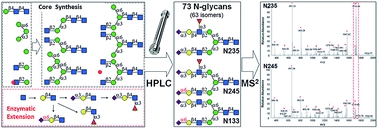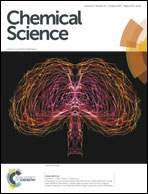Efficient chemoenzymatic synthesis of an N-glycan isomer library†
Abstract
Quantification, characterization and biofunctional studies of N-glycans on proteins remain challenging tasks due to the complexity, diversity and low abundance of these glycans. The availability of structurally defined N-glycan (especially isomer) libraries is essential to help solve these tasks. We report herein an efficient chemoenzymatic strategy, namely Core Synthesis/Enzymatic Extension (CSEE), for rapid production of diverse N-glycans. Starting with 5 chemically prepared building blocks, 8 N-glycan core structures containing one or two terminal N-acetyl-D-glucosamine (GlcNAc) residue(s) were chemically synthesized via consistent use of oligosaccharyl thioethers as glycosylation donors in a convergent fragment coupling strategy. Each of these core structures was then extended to 5 to 15 N-glycan sequences by enzymatic reactions catalyzed by 4 robust glycosyltransferases. Success in synthesizing N-glycans with Neu5Gc and core-fucosylation further expanded the ability of the enzymatic extension. Meanwhile, high performance liquid chromatography with an amide column enabled rapid and efficient purification (>98% purity) of N-glycans in milligram scales. A total of 73 N-glycans (63 isomers) were successfully prepared and characterized by MS2 and NMR. In summary, the CSEE strategy provides a practical approach for “mass production” of structurally defined N-glycans, which are important standards and probes for glycoscience.


 Please wait while we load your content...
Please wait while we load your content...